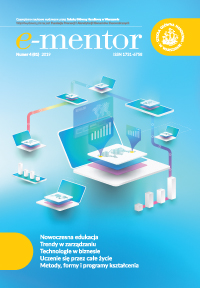Autoprezentacja zawodowa internautów w portalu społecznościowym LinkedIn.com
Professional self-presentation of LinkedIn portal users
Author(s): Aneta ParzońSubject(s): Social Sciences, Economy, Communication studies
Published by: Szkoła Główna Handlowa w Warszawie, Fundacja Promocji i Akredytacji Kierunków Ekonomicznych
Keywords: online self-presentation; professional self-promotion; professional social media; social communication; self-presentation behaviors; LinkedIn.com; transactional analysis by E. Berne; taxonomy of self-
Summary/Abstract: The dynamic development of new technologies has influenced the popularization of social media, which is a space intended for interpersonal communication. It allows people to establish and maintain contacts, but it also offers a wide range of possibilities in the context of image building. Professional social media, mainly for professional self-presentation, is also gaining popularity. It is therefore important to stimulate reflection on this issue, so that users construct their online images not only more consciously, but also more skillfully - to effectively support career design.In this study, the author presents the results of her own research, the aim of which was to discover the methods of self-presentation used by active users of LinkedIn.com. The research identifies, first of all, self-presentation behaviors based on the taxonomy of E.E. Jones and T.S. Pittman and, secondly, dominant competences (affective, cognitive, affective and cognitive). The theoretical basis of the tool for recognizing the dominant competences in the users' self-presentations is provided by the concept of transactional analysis (TA) by E. Berne. The research results allow one to conclude that internet users presenting themselves on LinkedIn.com use positive self-presentation and, above all, the strategy of self-promotion. The author identifies such self-presentation behaviors as declarations of competence, ingratiation (including the creation of similarities between the user and the recipient and expressing sympathy), exemplification and props of competence. Cognitive competences prevail both in self-description and in other parts of the analyzed profiles.
Journal: e-mentor
- Issue Year: 81/2019
- Issue No: 4
- Page Range: 71-78
- Page Count: 8
- Language: Polish

